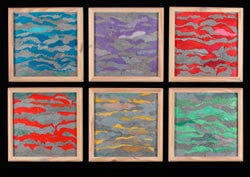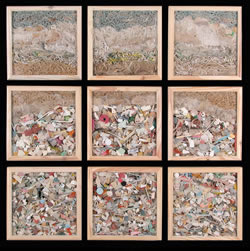Environmental artist John Dahlsen, had a selection of his artwork featured throughout the house in the Australian Big Brother 2007 series. Dahlsen was invited to exhibit his artwork exclusively throughout the house following the development of the “Green theme” for the 2007 Australian Big Brother house. Here is what he had to say:
…I see the opportunity to show my work in the Big Brother House as a way of sharing my message of the need to care for our environment with a broad audience...
…I believe humanity is presently at a critical point in time. Our planet currently exists in a fragile ecological state and global warming is hastening unheard of changes. We need all the help we can get. This is my way of making a difference…
…I hope this selection of artworks in the Big Brother House will add a new dimension for the housemates, which will possibly have them thinking about the deeper meaning of the work, in particular the environmental issues we currently face...

“Zebra Plastics”

“Blue River”

“Coloured Plastics”
The artwork ‘Coloured Plastics’, made from recycled plastic bags, has been donated
by the artist, through the Big Brother Australian web site, as a fundraiser for the environmental organizations “Clean Up Australia” and “Clean Up the World”.

“Orange Rope”

“Pastel Plastics”

“6 Buoy Totems”

“Blue Rope”
Byron Bay artist John Dahlsen’s artworks featured in the ‘07 Big Brother House
Environmental artist John Dahlsen, had a selection of his artwork featured throughout the house in the Big Brother 2007 series. Dahlsen was invited to exhibit his artwork exclusively throughout the house following the development of the “Green theme” for the 2007 Big Brother house.
The 2007 Big Brother series was broadcast daily nationally, for 14 weeks on Channel 10.
Big Brother 2007 Eco Art in the House
The artworks displayed in the House were by John Dahlsen – the Wynne Prize winning environmental and installation artist based in Byron Bay, who has over the years created his masterpieces from discarded or ‘found’ objects.
During his daily walks on the beach for over a 10 year period, John collected all the washed up ocean litter he found along the shoreline – old thongs, pieces of plastic, netting, foam, plastic bags and other flotsam and jetsam. He then took it all back to his studio and sorted it into to categories of colour. This motley collection of litter became the artist’s palette he created his unique artworks from.
By reinterpreting objects of the mundane and everyday, Dahlsen has made a comment on contemporary art and our disposable culture that creates so much waste and rubbish.
Objects, which would otherwise be considered garbage, have been recycled into things of beauty and given new meaning.
These are some responses to questions given to him by the Big Brother organizers, which help to put John Dahlsen’s involvement in the series in context.
How do you feel about having your art displayed in the Big Brother House?
John Dahlsen – “I see the opportunity to show my work in the BB House as a way of sharing my message of the need to care for our environment with a broad audience. When I was presented with the average nightly viewer figures [from the 2006 Big Brother series], which was in excess of 1.3 million viewers per night for 14 weeks, as well as over 2.2 million viewers on the opening night, I was immediately attracted to the idea, feeling that even if just a fraction of that audience were to experience a shift in their awareness and consciousness about the environment and art through being exposed to this artwork of mine, then it would be worth it.”
You’re obviously an environmentalist as well as an artist…
John Dahlsen – “I believe humanity is presently at a critical point in time. Our planet currently exists in a fragile ecological state and global warming is hastening unheard of changes. We need all the help we can get.
This is my way of making a difference, and at the same time I’m giving examples of how we can recycle and reuse in creative ways. These artworks exemplify my commitment as an artist to express contemporary social and environmental concerns.
What would you like the Housemates to get out of your art?”
John Dahlsen – “I hope this selection of artworks in the Big Brother House will add a new dimension for the Housemates, which will possibly have them thinking about the deeper meaning of the work, in particular the environmental issues we currently face. I hope these works serve to add a new level of sophistication to the House as well, and act as a constant reminder to the housemates about awareness.”
Big Brother auctioned John’s donated artwork “Coloured Plastic’ as a fundraiser for the environmental organizations “Clean Up Australia and Clean Up the World”, on the Big Brother Auction Site – Launched 30th April 2007
The artist also said that by being involved with exposure to such a large popular culture national audience, it is bound to have the potential of a far greater reach than the usual gallery environment.
Article from: The Courier – Mail May 30, 2007
By Mike O’Connor “When art meets trash”
Artist John Dahlsen
HE appears to be everything that Big Brother is not – earnest, intelligent, well-mannered and concerned about the wellbeing of those with whom he shares the planet.
I decline the herbal tea and opt for Bushells. There’s not a Monte Carlo or Iced Vo-Vo in sight, so I take a handful of raw peanuts from the plate on the table.
It’s late in the day, and from the deck of this Byron Bay retreat I watch a herd of cows plodding homewards across a far paddock.
There is, however, a nexus between John Dahlsen and Big Brother, for it is his artwork that hangs on the walls of the Big Brother house, a symbol of the latest series’ attempt – in between under-blanket gropes and midnight bonks – to embrace the message of environmental consciousness.
We walk around to his incredibly tidy studio, past a totem-pole-like artwork made of several hundred thongs, and he explains his involvement with BB.
“The executive producer approached me and gave me this pitch, and when I was presented with the sort of audience figures they could reach, I felt there was the potential to take advantage of them and use them to make a difference,” he says.
“They contacted me because I was known as an environmental artist and they said the house was going to have a green theme.
“I thought that if my art could make an imprint on even a small part of that viewing public and show them to view the environment in a different way and get the environmental message, then it was worth it.”
Dahlsen exudes that aura of health that comes from exercise and a careful diet. He and his wife Rago walk the several kilometres from their property to the Byron Bay lighthouse every morning, and my bet would be that they don’t stop for a blueberry muffin on the way home.
“My hope was to lend a degree of sophistication to the debate in the house that wasn’t there previously,” he says. “I’m biased, but I hope the artworks add something, another level.”
I wonder privately whether most of the BB inmates can even spell “environment”, but admire Dahlsen’s optimism.
“I feel the planet is in very fragile shape. I believe it could go either way, and I felt that by joining with Big Brother I could do my bit to help,” he explains.
His motives were initially misconstrued by some of his associates, who accused him of selling out to the forces of commercialism, but he claims to have won them back.
“It doesn’t take too much intelligence to see what my intentions were. Some people saw my artworks on the program and judged me because they weren’t aware of the green theme,” he says.
As the light fades we leave his studio and he walks me through Cape Heritage, a four- bedroom luxury home which he and Rago rent to tourists by the week.
“I enjoy it,” he says of his dual artist-landlord role. “It’s a big property, and there’s plenty of privacy for the house guests and for us. We live in very separate accommodation, but it’s fun for guests who may want to view my work.”
Dahlsen was a traditional painter living in Western Australia when he took up the environmental banner.
“I’ve worked with ‘found’ and recycled objects for about 10 years now, and I’ve done everything from large public artworks to private commissions and paintings,” he says.
Back in his studio, he shows me part of his portfolio.
“It’s a broad spectrum,” he says.
I’d rather pluck out my eyelashes than step into a modern art gallery, but find myself impressed by Dahlsen’s works executed with “found” objects such as plastic bags and chunks of plastic detritus.
More recently, however, his concerns about the future of the planet have moved him to change focus.
“l’ve actually gone back to painting more traditional landscapes and seascapes of Byron Bay and its surrounds,” he says.
“It’s an area which is incredibly precious to me. The more I read about global warming, I get glimpses of untold changes which could happen anytime – tomorrow.
“It concerns me to the point where I want to start recording some of the beauty of this area, because I don’t know what’s going to happen in the near future, plus painting these is giving me a huge amount of joy.
“I was reading this morning that the melting of the icecaps is happening at least three times faster than what is being reported. That sort of thing can only bring about cataclysmic changes.
“I’ve never been a doomsayer. The positive side is that it can bring about quantum shifts in the consciousness of people on this planet – and probably will, and help to take us into the next age, whatever that is going to be,” he says, shrugging.
Dahlsen has collected his “found” material all along the northern NSW coastline, a latter-day beachcomber.
“I’ve even been to South Stradbroke Island, where I was artist in residence at Couran Cove at one stage,” he says.
“I walked up and down the 17km of beach there, and over a couple of weeks collected 70 or 80 jumbo garbage bags full of things that had washed up on the shore.”
As I leave I pause by the thong totem.
“I won the Wynne Prize with a few works like that,” he says.
“That’s a lot of thongs,” I say. “Did you pinch them?”
“No,” he says, horrified. “I found them on the beach!”
“Just joking,” I say, smiling, while eyeing off a red one which looked suspiciously like one-half of a pair I lost in the beer garden of the Point Lookout Hotel in 1983.
